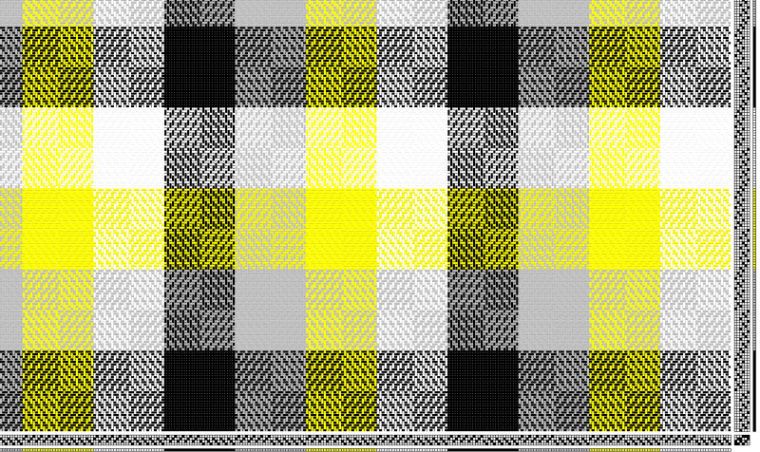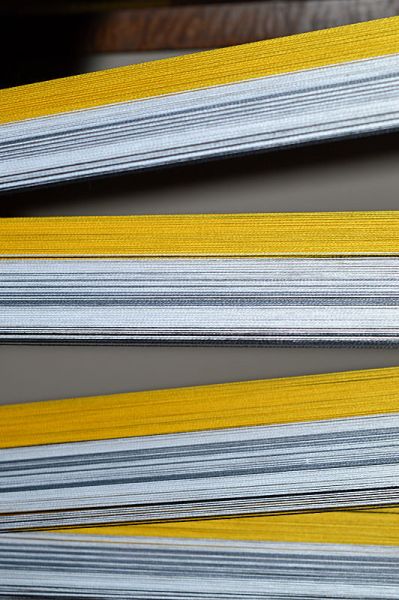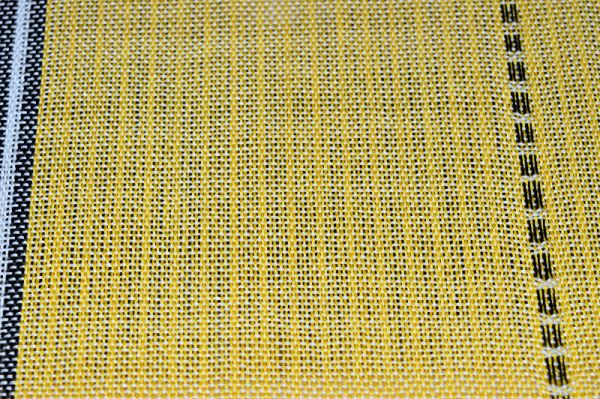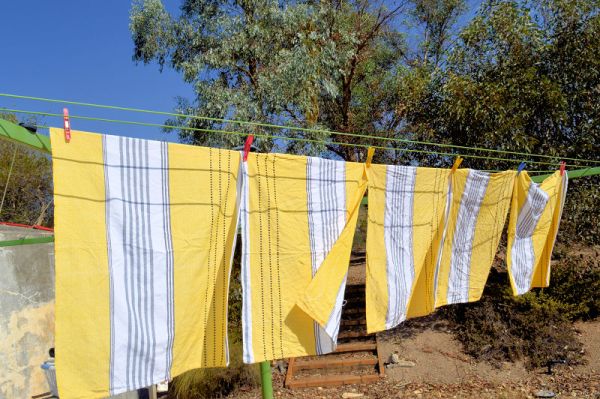While hanging out the washing last month, I noticed that my tea-towels were threadbare and developing holes. And so my summer weaving project was decided for me.
Initially I had planned to make something like this turned twill design, in pale yellow, silver and white.

That design is for 8-shafts, but I was able to work out a similar design using false damask that I could do on my 4-shaft loom. Feeling quite smug at this point

Not so smug when the order for my yarns arrive, and find that the yellow is a deep golden colour and the grey is about 70% black. Nice, but in my chosen design—> hazard sign! Plan B, is to use plain weave, with a white weft to help tone down the colours. A few stripes to give a little interest, Fibonacci widths for visual appeal, and supplemental weft for something new for me to try. A little time spent playing with yarn wrapping lead to the main idea. From there I adjusted the widths to match Fibonacci proportions.

Supplemental weft was thrown in because last year I had shown DH a picture of the bobbins from Ashford, and asked if he could turn a few ( well half a dozen) for me. He disappeared into the shed, the sound of the lathe whirring and then the chatter of wood being shaped into a round. Moments later he appeared with Example A, made using Casuarina; I love the medullary rays in this timber. Example B, was a little smaller and made in Red Gum. Finally Example C was the size I wanted and very soon I had a baker’s dozen in Silvertop Ash.

(L) Casuarina (M) Red Gum (R) Silvertop Ash
Winding the warp, I made a couple of (unplanned) changes to the design due to counting mistakes and running out of the yellow thread. It looked quite dramatic on the warping pegs. But it toned down a bit as I started to weave.

My denting was 3-2-2 and as I started to weave, I could see reed marks in the cloth (the darker bands where the threads are closer together). I didn’t like the look in that sample and resleyed the reed to 2-2-2, but this was too open. Dismayed, I googled ‘reed marks’ and found a few posts showing how the reed marks disappear after washing. So, fingers crossed, I reslayed the reed back to the original and ploughed on.

I tend to weave sporadically, going as far as a full bobbin will take me, occasionally two or three. After a while, the weaving is done, and inch of twill separates each of the towels. It gets cut off the loom, the hems zig-zagged before being cut apart. A double folded hem, machine stitched down and it’s in with the wash they go.

They did look quite nice fapping around in the breeze against the blue sky. Looking closely, I can still see faint reed marks, but you wouldn’t really notice it unless you were looking for it.
The yarn for this project cost wasn’t cheep, costing about $10 per towel. Not exactly economical, but like they say ‘I good hobby is cheaper than therapy!”

Wow! I continue to marvel at your abilty to conceive and execute projects to completion! So impressive. I love these. $10 seems very reasonable for a good quality tea towel, by the way. How long did this take?
LikeLike
Thanks Lyndle. I’ve been working on them for about 6 weeks. Usually it will take me a full day to wind the warp and setup the loom ( with lots of breaks). The actual weaving is done in short bursts, so it’s a bit hard to judge. One of my goals for the year is to make a handwoven bomber jacket. I should get started on it now, so that the fabric might be ready in time for winter.
LikeLike
Those are really lovely!
LikeLike
Wow! Treefrog, you are so talented!!! 🙂 Those are beautiful.
LikeLike
These are gorgeous! They will be so cheerful as you go about your day in the kitchen. Yellow and gray are one of my favorite color combos. Yes, definitely, a good hobby is better than therapy.
LikeLike
So very impressive! And how handy to have your husband’s talents for your hobby too. Your tea towels are pretty.
LikeLike
Yes, it’s great that DH is a keen woodworker. He’s made all my shuttles as well.
LikeLike
They’re beautiful!
LikeLike
Love the colors!
LikeLike
Such cheery tea towels. Definitely worth the cost. I love the combinations of stripes you came up with and I always love a bit of Fibonacci sequence!
LikeLike